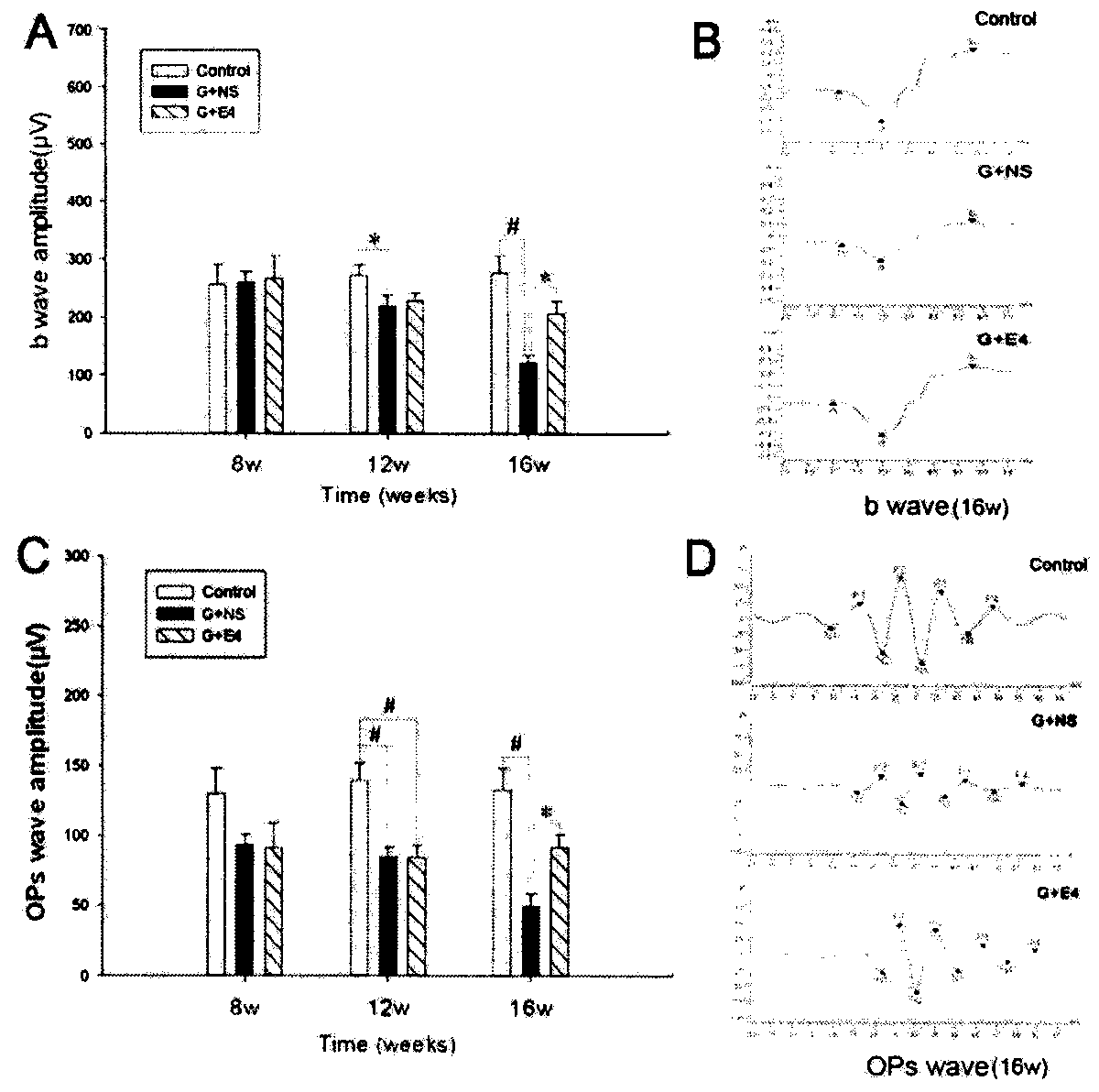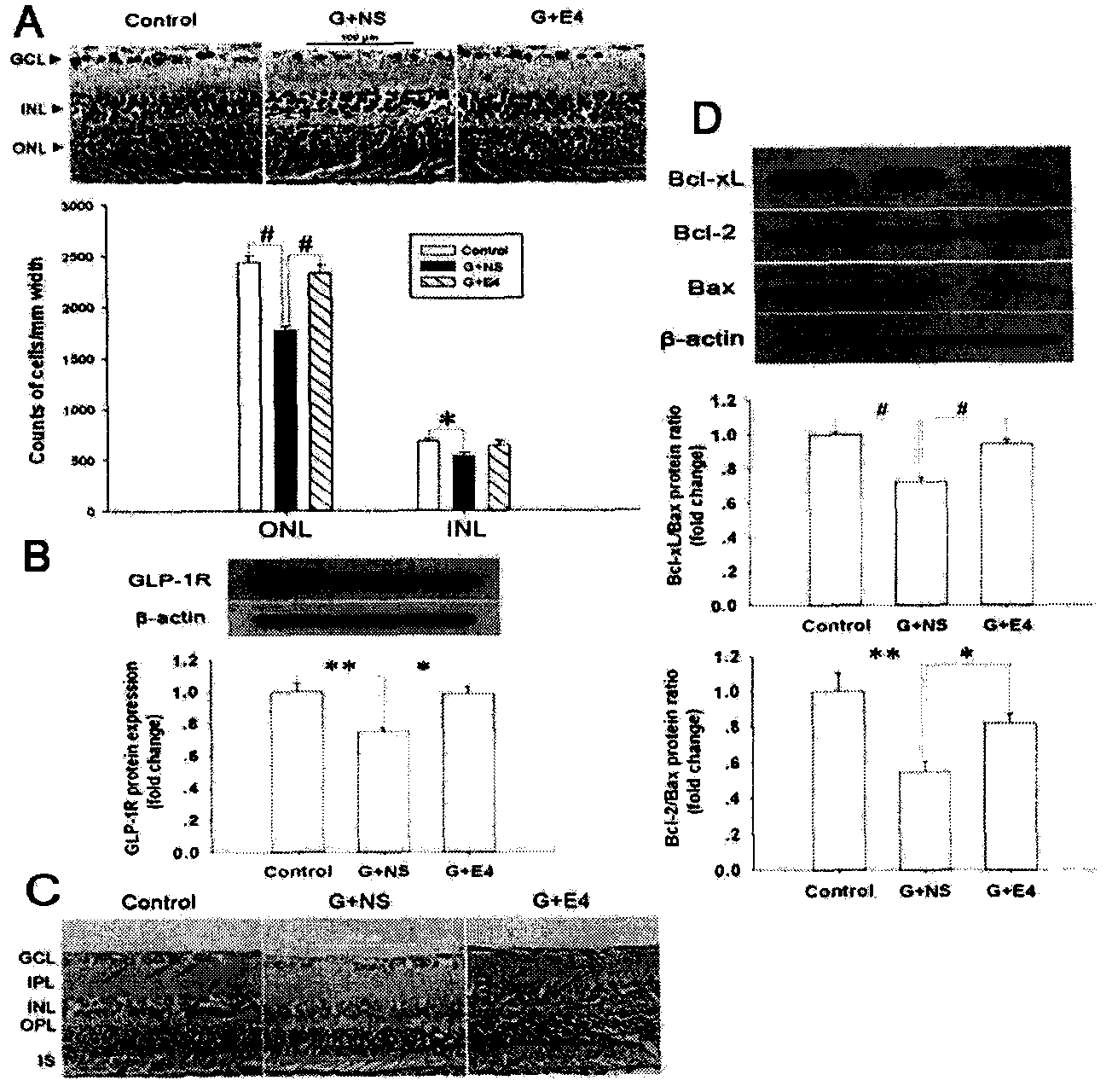Use of glucagons-like peptide-1 analogue in preparation of ophthalmic disease drug
A technology for ophthalmic diseases and analogs, which is applied in the field of preparation of drugs for the treatment of ischemic or nerve-injured ophthalmic diseases, glucagon-like peptide-1 analogs, which can solve problems such as unsatisfactory prognosis and improve visual function , the effect of inhibiting the retinal inflammatory response
- Summary
- Abstract
- Description
- Claims
- Application Information
AI Technical Summary
Problems solved by technology
Method used
Image
Examples
Embodiment 1
[0038] Example 1 Intravitreal injection of Exendin-4 has the effect of protecting the retinal function of rats, making the total amplitude of ERG b wave and 0ps close to the normal level
[0039]The degree of diabetic retinopathy in rats and the functional state of the retina were detected by the method of full-field flash ERG. The results showed that at 16 weeks, the amplitudes of b waves and Ops waves of rats injected with GK normal saline decreased significantly, which was higher than that of Wistar. Rats were reduced by 43.9±4.7% (eg figure 2 A, B shown) and 37.4±6.8% (as shown figure 2 Shown in C and D), while the amplitude of GK rats E4 treatment group was significantly increased, the amplitude of b wave was 206.7±21.5mV (121.2±12.9mV for GK rats, P<0.05), and the amplitude of Ops was 91.7±9.0mV (GK rats are 49.6 ± 9.1mV, P<0.05), there is no significant statistical difference between the b wave and Ops amplitude of GK rat E4 treatment group and Wistar rats, suggestin...
Embodiment 2
[0040] Example 2 Intravitreal injection of Exendin-4 can prevent the thinning of diabetic retina and the loss of cells in each nuclear layer, and make the morphological indicators such as retinal thickness and outer nuclear layer cell count in diabetic rats approach to normal levels.
[0041] The results of HE staining and morphological examination showed that in the retina of 16-week-old GK rats, GCL, INL, and ONL layers were significantly reduced compared with Wistar rats, and the initial cell loss appeared in the ganglion cell layer (61.3% ± 4.8%, n=12; p image 3 Shown in A and B) and outer nuclear layer (72.5±1.8% of Wistar rats, n=12; p image 3 Shown in A), in the inner nucleus layer of the retina, there is also obvious cell loss (78.7±5.3% for Wistar rats, n=12; p image 3 Shown in A), Exendin-4 can significantly reduce the cell reduction in the ganglion cell layer and the outer nuclear layer, and the ganglion cell count and the outer nuclear layer cell count in the Exendin...
Embodiment 3
[0042] Example 3 Intravitreal injection of Exendin-4 can increase the expression of GLP-1R and increase the expression of anti-apoptotic gene Bcl-xL Bcl-2, thereby inhibiting the apoptosis of diabetic retinal cells
[0043] The expression of GLP-1R was significantly down-regulated in 16-week-old GK rats compared with Wistar rats (75.1±2.8% of Wistar rats, such as image 3 shown in B), but the Exendin-4 treatment group was significantly up-regulated (131.3±6.2% of GK rats, such as image 3 Shown in B), the immunostaining of retinal GLP-1R is consistent with the expression of GLP-1R detected by Western blot (such as image 3 C), immunohistochemistry showed that GLP-1R was mainly expressed in the inner retinal layer (including ganglion cell layer, inner plexiform layer, inner nuclear layer) and the inner segment of photoreceptors (such as image 3 C shown);
[0044] Western blot detection of the expression of mitochondria-dependent apoptosis-related genes (Bcl-2, Bcl-xL and Bax...
PUM
 Login to View More
Login to View More Abstract
Description
Claims
Application Information
 Login to View More
Login to View More - R&D
- Intellectual Property
- Life Sciences
- Materials
- Tech Scout
- Unparalleled Data Quality
- Higher Quality Content
- 60% Fewer Hallucinations
Browse by: Latest US Patents, China's latest patents, Technical Efficacy Thesaurus, Application Domain, Technology Topic, Popular Technical Reports.
© 2025 PatSnap. All rights reserved.Legal|Privacy policy|Modern Slavery Act Transparency Statement|Sitemap|About US| Contact US: help@patsnap.com



